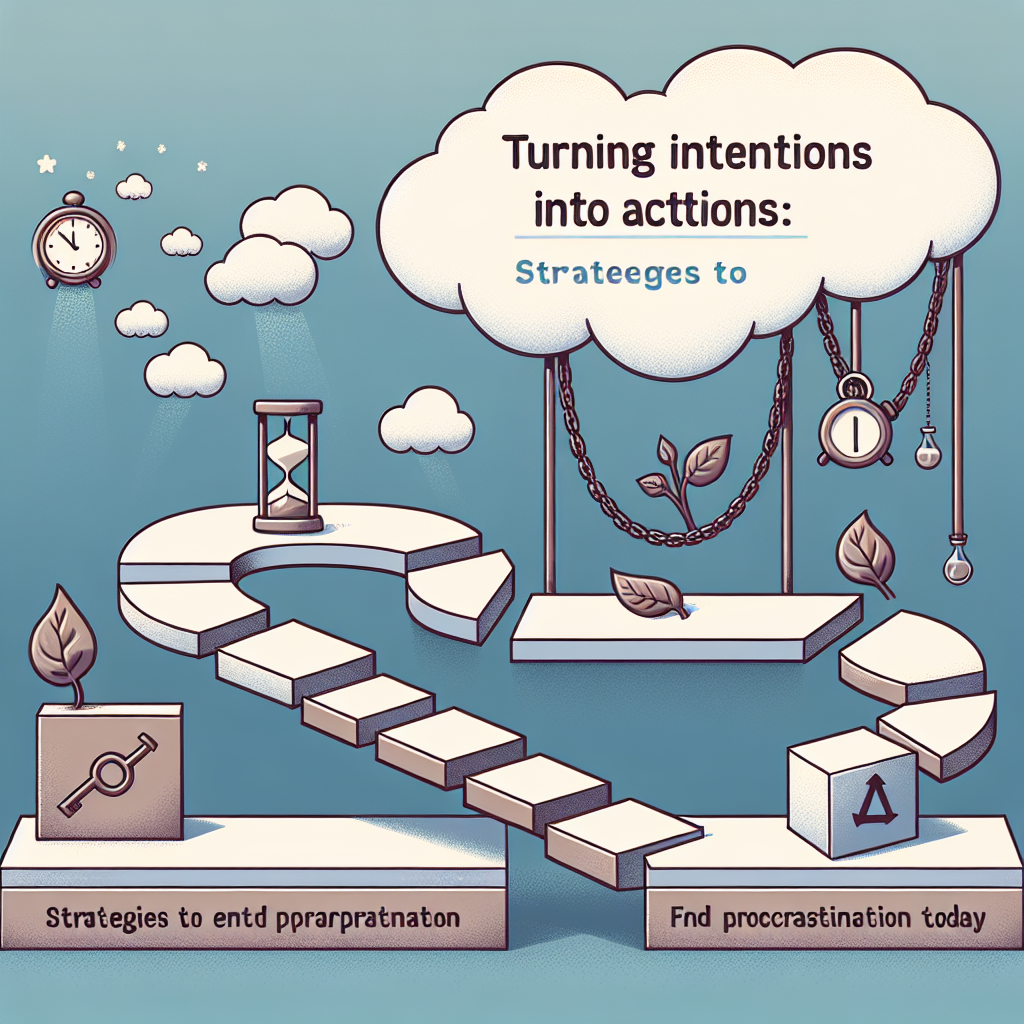Turning Intentions into Actions: Ultimate Strategies to End Procrastination Today
Introduction
Have you ever found yourself staring at an ambitious to-do list, fully aware of the tasks waiting to be tackled, yet feeling immobilized by the weight of procrastination? If this sounds familiar, you’re not alone. Procrastination is an insidious plague that can sap our productivity and impact our well-being. The struggle between our intentions and actions is a common human experience.
In "Turning Intentions into Actions: Strategies to End Procrastination Today," we will explore transformative strategies to bridge that gap. Let’s dive into practical methods, real-world examples, and actionable insights that will empower you to overcome procrastination and make your intentions a reality.
Understanding Procrastination
The Nature of Procrastination
Procrastination isn’t simply laziness; it’s a complex psychological and emotional issue. Studies show that procrastination can stem from several factors, including fear of failure, perfectionism, and lack of motivation. Understanding the root causes of our procrastination is the first step towards finding effective strategies to overcome it.
Case Study: John’s Journey
John, a software developer, struggled with completing projects on time due to his constant avoidance behavior. After attending a seminar focused on "Turning Intentions into Actions: Strategies to End Procrastination Today," he learned to identify his fear of failure and began to implement small, manageable tasks that gradually led him to complete his projects on schedule.
Strategies to Overcome Procrastination
1. Set Clear Goals
Defining Your Objectives
To transform your intentions into actions, setting clear and specific goals is crucial. Vague goals lack direction and make it easy to procrastinate. Use the SMART criteria (Specific, Measurable, Achievable, Relevant, Time-bound) to ensure your goals are well-defined.
Implementation Tips
- Break Goals Down: Divide larger goals into smaller, manageable tasks. This makes the process less overwhelming and easier to tackle.
-
Create S.M.A.R.T. Goals: Element Description Specific What do you want to achieve? Measurable How will you measure your progress? Achievable Is it realistic based on your current situation? Relevant Why is this goal important to you? Time-bound When will you achieve it?
2. Time Management Techniques
The Pomodoro Technique
Consider using the Pomodoro Technique, which encourages work in focused intervals (usually 25 minutes) followed by short breaks. This strategy enhances focus and makes daunting tasks feel manageable.
3. Eliminate Distractions
Creating a Productive Environment
Identify and eliminate distractions in your work environment. This may include silencing notifications or even using focus apps to limit access to social media.
Case Study: Sarah’s Focus
Sarah, a graduate student, struggled to focus on her thesis due to constant distractions from her phone. By creating a dedicated study space and using website blockers, she found that she was able to work more efficiently, illustrating the importance of a suitable environment in "Turning Intentions into Actions: Strategies to End Procrastination Today."
4. Build Accountability
The Power of Social Accountability
Engage with someone who can hold you accountable for your goals—friends, colleagues, or a coach. Sharing your intentions increases your commitment and decreases the likelihood of deferring tasks.
Actionable Steps:
- Join a study group.
- Find an accountability partner.
- Utilize online accountability platforms.
5. Foster a Growth Mindset
Embracing Challenges
Adopting a growth mindset encourages individuals to view challenges as opportunities for learning rather than obstacles. This shift in perspective can diminish the fear associated with failure.
6. Visualize Success
The Power of Visualization
Visualization techniques, such as creating vision boards, can help clarify your intentions and serve as a daily reminder of your goals. When you visualize the outcomes of your actions, it fosters motivation to take necessary steps.
Table: Visualization Techniques
| Technique | Description | Example |
|---|---|---|
| Vision Board | A collage of images representing goals. | A poster with health goals. |
| Mental Imagery | Visualizing achieving goals vividly. | Imagining a successful presentation. |
Conclusion
Transforming intentions into actions requires commitment, understanding, and practical strategies. Through goal-setting, time management, distraction elimination, accountability, a growth mindset, and visualization, you can conquer procrastination and take productive steps today.
Embrace the journey of self-improvement; after all, the best time to start was yesterday, but the next best time is now.
FAQs
1. What is procrastination?
Procrastination is the act of delaying or postponing tasks, often due to fear of failure, perfectionism, or lack of motivation.
2. How can I effectively set goals?
Use the SMART criteria to create Specific, Measurable, Achievable, Relevant, and Time-bound goals to provide clear direction.
3. How does the Pomodoro Technique work?
The Pomodoro Technique involves working in focused bursts of 25 minutes followed by 5-minute breaks, which helps maintain concentration and energy.
4. What are some common distractions I should avoid?
Common distractions include smartphones, social media, and noisy environments. Identifying what distracts you the most can help you eliminate these interruptions.
5. How can visualization help in overcoming procrastination?
Visualization motivates and clarifies your intentions by showing you what success looks like, making it easier to take action toward achieving your goals.
By applying the insights shared in "Turning Intentions into Actions: Strategies to End Procrastination Today," you can move closer to a life marked by decisiveness, productivity, and fulfillment. The first actionable step starts now—what will you accomplish today?

